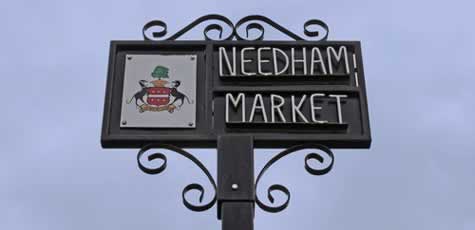
Does what it says on the tin – It’s a guided walk around Needham Market; a pretty little town on the A14 in the heart of Mid Suffolk. Taking in lots of historic buildings, this can easily be combined with a wander round Needham Lake (see our separate post)
Begin your walk at the Station approach and consider the Victorian Railway Station, designed in 1849. It was built on land bought from the Theobald Foundation for £275. As originally built with curved Dutch gables it was a miniature Blickling Hall
Continue towards the High Street and see on your left Theobalds Grammar School, established in the seventeenth century and used as a school until the early part of the twentieth century
Facing you is Chainhouse Farm. In 1663/5 Needham Market was isolated due to the plague and a chain was erected at both ends of the town, hence the names still in use,’Chainhouse’ at the south end and ‘Chainbridge’ at the north. The chains would not have been an effective physical barrier so they must have acted as a psychological deterrent. The plague marked the decline of the wool trade in the town.
Turn right along the High Street to number 12, formerly the Waggon and Horses Public House. Built in 1591 as New Hall it is now a private dwelling called The Waggon. Continue to Christchurch, previously the United Reformed Church which, in its present building dates from 1837. The scientist, Joseph Priestly, was minister from 1755 to 1758. He discovered oxygen and worked on the nature of gases, inventing soda water.
On the left is the Town Hall, opened in 1866 and designed by Frederick Barnes. Across The Causeway are the Almshouses which housed two medieval carvings, probably survivals of earlier buildings on this site, and are now situated in St John the Baptist Church porchway.
Further up the High Street on the right is The Pightle.
Converted domestic buildings stand at the rear of what was the ‘Kings Head’ public house until the early years of the twentieth century.
The present Post Office, on the left, was the Quakers Meeting House and Graveyard. The building dates from 1772 and was an important centre for the Friends for several generations. Many Quaker families are buried in the graveyard including the Alexanders.
On the right the Bull Inn has a finely carved Angel Corner Post. The Limes Hotel on the left is where the Guilds met. It was a calling house for pilgrims on their way to Bury St Edmunds and believed to have been named Boule House. The Georgian facade masks Tudor carvings and oak beams.
Tudor House, also on the left, is a fine timbered house typical of many fifteenth and sixteenth century houses which lie behind the brick facades in the High Street. Once the home of George Ewart Evans, who has written many books based on the oral reminiscences of Suffolk people.
Needham Market Church, on the right, dates mainly from the mid fifteenth century. Inside is a magnificent roof which is, “the culminating achievement of the English Carpenter”, (Munro Cautley).
Barclays Bank, previously Alexander’s Bank, founded by the Quaker family as one of the earliest private banks in England, and moved to its present site in 1756.
The Ancient House, on Hawks Mill Street, was built in 1480 and has been much restored. The garden wall still bears a plaque stating that the Suffolk Agricultural Show was held in the town in 1893. Continue down Hawks Mill Street to Hawks Mill. There has been a mill on this site since Doomsday times. The present building dates from 1887 and is now converted to residential use. There are many other very old and interesting buildings in the town, many of them hiding behind modern facades. The whole High Street is designated a Conservation Area and most of the buildings are Grade II listed
Last Updated on December 17, 2019 by Laura